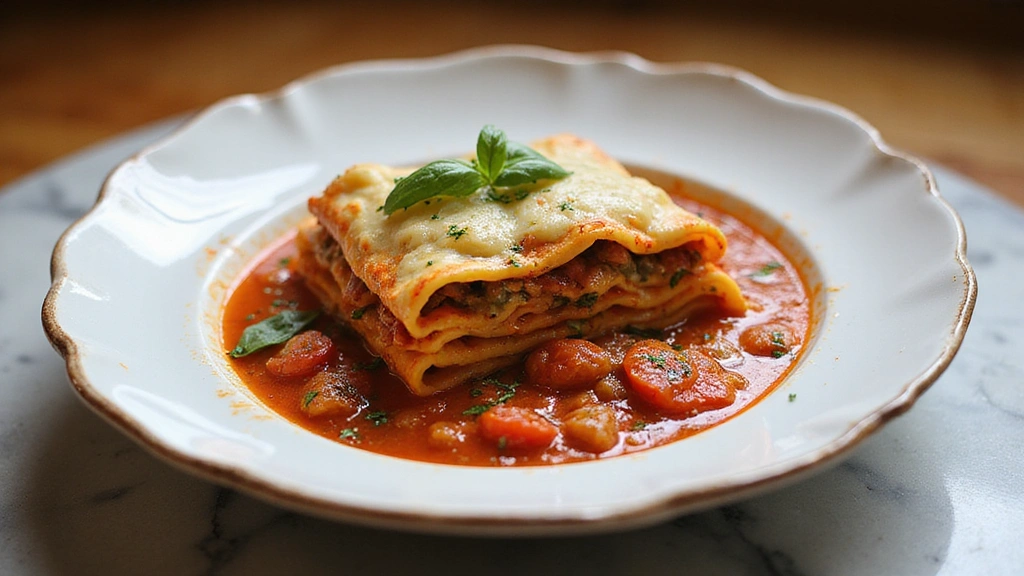Lasagna soup is the perfect fusion of comfort food and convenience, capturing the rich flavors of traditional lasagna in a warm, hearty bowl.
This dish offers all the cheesy, tomatoey goodness you love, without the hassle of layering noodles.
I stumbled upon this delightful recipe during a chilly autumn evening when I craved something cozy yet different.
The aromatic blend of herbs and spices will transport your taste buds straight to an Italian kitchen.
Whether you’re hosting a dinner party or simply enjoying a quiet night in, lasagna soup is a guaranteed hit.
The History and Cultural Significance
• Lasagna Soup Recipe traces its origins to Italy, evolving from the classic lasagna dish.
• The dish evolved over decades as cooks sought quicker, simpler ways to enjoy lasagna’s flavors, leading to the creation of this soup version.
• In Italy, this dish traditionally appears at family gatherings, symbolizing warmth and togetherness.
• While many variations exist across different regions, the authentic version maintains a hearty broth and rich flavor that sets it apart from imitations.
Recipe Overview
Nutritional Information (per serving)
Essential Equipment Guide
Large Dutch Oven or Pot: A large Dutch oven is crucial for evenly cooking the soup and maintaining the perfect temperature. An alternative can be a heavy-bottomed pot, which also distributes heat well. Look for one with a tight-fitting lid to trap flavors.
Slotted Spoon: This tool is essential for removing cooked noodles or meat from the pot without taking too much liquid. If unavailable, a regular spoon can work, but it might not be as effective. Opt for stainless steel for durability.
Immersion Blender: This helps achieve the perfect texture by pureeing some of the soup directly in the pot. A regular blender can be used as an alternative, but it requires transferring hot liquids, which can be cumbersome.
Ingredients
For the Base
|
|
| Amount | Ingredient | Notes |
|---|---|---|
| 1 pound | ground beef | adds richness and protein |
| 1 tablespoon | olive oil | for sautéing |
Vegetables
| Amount | Ingredient | Notes |
|---|---|---|
| 1 large | onion | finely chopped |
| 2 cloves | garlic | minced |
For the Sauce
| Amount | Ingredient | Notes |
|---|---|---|
| 28 ounces | crushed tomatoes | provides a robust base |
| 4 cups | chicken broth | creates a flavorful broth |
Seasonings
| Amount | Ingredient | Notes |
|---|---|---|
| 1 teaspoon | dried oregano | classic Italian flavor |
| 1 teaspoon | dried basil | adds aromatic sweetness |
| 1/2 teaspoon | red pepper flakes | for a hint of heat |
Pasta
| Amount | Ingredient | Notes |
|---|---|---|
| 8 ounces | lasagna noodles | broken into bite-sized pieces, adds texture |
Cheese
| Amount | Ingredient | Notes |
|---|---|---|
| 1 cup | ricotta cheese | for creaminess |
| 1/2 cup | parmesan cheese | adds umami and depth |
Preparation Methods
Sautéing: Sautéing is critical for developing deep flavors in the soup. It involves cooking onions and garlic in olive oil until they're soft and fragrant, which helps release their natural sweetness. Use a medium heat to avoid burning, and stir frequently for even cooking.
Simmering: This technique allows the flavors to meld together over a gentle heat. It's important for softening the noodles and thickening the soup. Keep the pot partially covered to prevent evaporation while retaining enough liquid.
Cheese Dolloping: Adding dollops of ricotta cheese before serving gives the soup a creamy finish. Use a spoon to drop small amounts evenly into each bowl, allowing it to slowly melt and integrate into the soup.
Step 1: Prepare Ingredients

Gather all your ingredients.
Chop the onion and mince the garlic.
Break the lasagna noodles into bite-sized pieces.
Measure out the spices and broth.
Step 2: Sauté the Aromatics

Heat olive oil in a large Dutch oven over medium heat.
Add the chopped onion and sauté until translucent.
Stir in the minced garlic and cook for another minute.
Ensure the ingredients are soft and fragrant.
Step 3: Brown the Meat

Add ground beef to the pot.
Cook until browned, breaking up the meat as it cooks.
Drain excess fat if necessary.
Make sure the meat is fully cooked and no longer pink.
Step 4: Add Liquid Ingredients

Pour in the crushed tomatoes and chicken broth.
Stir to combine everything evenly.
Bring the mixture to a gentle simmer.
Ensure the broth is well mixed with the tomato base.
Step 5: Season the Soup

Add oregano, basil, and red pepper flakes.
Stir the seasonings into the soup.
Taste and adjust the seasoning if needed.
The soup should have a balanced, aromatic flavor.
Step 6: Cook the Noodles

Add the broken lasagna noodles to the pot.
Stir occasionally to prevent sticking.
Cook until the noodles are al dente.
Check for the right texture: tender but firm.
Step 7: Incorporate Cheese

Mix ricotta cheese with a bit of soup broth in a bowl.
Dollop the ricotta mixture into the soup.
Allow it to melt slightly.
The ricotta should create creamy pockets within the soup.
Step 8: Serve and Garnish

Ladle the soup into bowls.
Sprinkle parmesan cheese over each serving.
Add fresh basil or parsley for garnish.
The soup should be hot and garnished attractively.
Critical Timing and Temperature Guide
Sautéing Aromatics: Cook onions for 5-7 minutes over medium heat until translucent; avoid browning for a balanced flavor.
Simmering Soup: Simmer over low heat for 20-25 minutes; look for slightly thickened broth and tender noodles.
Cheese Incorporation: Add ricotta just before serving; avoid overheating to prevent curdling.
Pro Tips for Lasagna Soup Recipe
• Ingredient Selection: Choose high-quality crushed tomatoes and fresh ricotta for the best flavor impact.
• Preparation Secret: Toast the spices briefly in oil before adding other ingredients to intensify their flavors.
• Temperature Management: Use medium heat for sautéing to prevent burning, and low heat for simmering to meld flavors.
• Texture Enhancement: Cook noodles separately if you prefer firmer texture and to prevent them from absorbing too much broth.
• Flavor Layering: Add a splash of balsamic vinegar for depth and complexity before serving.
• Make-Ahead Strategies: Prepare the soup base a day in advance; store in the fridge and add noodles when reheating.
• Restaurant-Quality Finishing Touches: Drizzle with a touch of extra virgin olive oil before serving for a luxurious finish.
• Equipment Optimization: Use a heavy-bottomed pot for even heat distribution, especially when simmering.
Troubleshooting Common Issues
• Soup Too Thick: If the soup is too thick, add more broth or water gradually until desired consistency is reached.
• Noodles Overcooked: Cook noodles separately and add just before serving to prevent them from becoming mushy.
• Flavors Not Balanced: Adjust seasoning by adding salt or acid (lemon juice or vinegar) incrementally to balance flavors.
• Cheese Curdling: Ensure soup is not boiling when adding cheese; lower temperature to prevent curdling.
• Meat Too Greasy: Drain excess fat after browning meat to avoid a greasy texture.
Variations and Regional Differences
• Vegetarian Version: Substitute ground beef with mushrooms or lentils for a vegetarian take, adding depth with vegetable broth.
• Spicy Southern Italian Style: Increase red pepper flakes and incorporate spicy sausage for a fiery kick.
• Cheesy American Style: Add cheddar cheese along with ricotta for a creamier, richer soup.
• Brothy Northern Italian Version: Use a lighter broth with more vegetables, such as zucchini and spinach, for a refreshing variation.
Food Science Behind the Recipe
• Maillard Reaction: Browning the meat enhances flavor through Maillard reaction, contributing to the soup's depth.
• Emulsification: Stirring cheese into the soup creates an emulsion, providing a rich, creamy texture.
• Gelatinization: Starch from noodles thickens the soup, demonstrating gelatinization as it cooks.
Frequently Asked Questions
What's the most common mistake people make when preparing Lasagna Soup? Overcooking the noodles, which causes them to become mushy and absorb too much broth.
Can I freeze Lasagna Soup? Yes, but it's best to freeze the soup without the noodles to prevent them from becoming too soft.
How do I make this dish gluten-free? Use gluten-free lasagna noodles and ensure other ingredients like broth are certified gluten-free.
What’s the best way to reheat leftover soup? Reheat gently on the stove over low heat, adding a bit of broth or water if needed to adjust consistency.
Can I use other types of pasta? Yes, any short pasta like penne or rotini can be used if lasagna noodles are unavailable.
Is it okay to use fresh tomatoes instead of canned? Fresh tomatoes can be used, but they should be cooked down longer to achieve a similar depth of flavor.
How can I make the soup more flavorful? Incorporate a parmesan rind while simmering and adjust spices to taste for enhanced flavor.
Serving and Presentation Guide
• Traditional Presentation: Serve in wide, shallow bowls with a generous sprinkle of parmesan and a basil leaf.
• Rustic Style: Serve with a slice of toasted garlic bread on the side for dipping.
• Family Style: Present in a large communal pot at the table, allowing guests to serve themselves.
• Gourmet Twist: Drizzle with truffle oil and add microgreens for an elevated presentation.
Conclusion
With its comforting flavors and simple preparation, lasagna soup is a must-try for any home cook.
This recipe captures the essence of traditional lasagna in a fraction of the time.
Invite your family and friends to join you for a cozy meal that will warm both body and soul.

